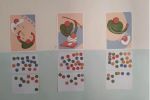As a parent, should I stop my children from fighting? As a teacher, should I beat children when they continue to disrupt the class, or when they refuse to pray? When confronted with such ethical questions, people’s choices are generally influenced by the normative rules that they know. For example, they are influenced by what their religion tells them to do, how the state and society tells them to act, or what their family thinks. We also have our own personal norms. Sometimes, these norms may contradict each other. Maybe you personally feel that you shouldn’t beat your children, while your family expects you to lightly beat your children when they misbehave. In such situations, what do you do?
Our recently published paper Navigating conflicting normative orders: when violence isn’t violence unpicks this dilemma as experienced by parents, educators, and children themselves living in the Sahrawi refugee camps near Tindouf, Algeria. We found that the Sahrawi participants in the study (both adults and children) used multiple normative orders to frame their understanding(s) of violence against children. Namely: the international legal order, the religious (Islamic) legal order, the national legal order, the traditional normative order (Urf), the community, the family and the school.
One of our key findings was that these different normative orders led to different conclusions about when violence against children is and isn’t permitted. Moreover, in contrast to most scholars of norm pluralism, the findings of our case study led us to theorise that rather than choosing between these contradictory norms, participants attempted to reconcile them. To explain this, we used the Sartrean concept of mauvaise foi to propose a new model for understanding how people deal with contradictory norms. Namely, we suggest that by redefining core concepts of norms, such as ‘children’ and/or ‘violence’, interviewees tried to resolve the apparent tensions between norms of different normative orders.
In this blogpost, I briefly introduce some of our key research findings in relation to contradictory norms that influenced research participants’ understanding(s) of violence against children in the Sahrawi refugee camps and illustrate how paradoxical reasoning was used to resolve the conflict between them.
In 1976, a large part of the indigenous Sahrawi population fled Western Sahara because of fighting between the Moroccan army, the Mauritanian army and the Polisario (Sahrawi liberation movement) over the territory. The refugees crossed the border into Algeria where the Algerian government allowed them to set up refugee camps – supported by the UN Refugee Agency – which are run by the Sahrawi Arab Democratic Republic (SADR) government-in-exile. To this day, the conflict remains unresolved. Consequently, multiple generations of Sahrawi children have grown up in the refugee camps. Currently, the UN Human Rights Council estimates there are approximately 65,000 children living in SADR-run camps.
To our knowledge, very little academic research has been conducted into the situation of children living in SADR refugee camps. This knowledge gap was the starting point of our inquiry into the development rights of Sahrawi children and different norms related to the protection/violation of these rights. Through exploratory interviews with Sahrawi children, we identified violence against children as a key issue. In particular, the children interviewed stated that they regularly experienced two forms of violence: 1) fighting between children and 2) beating by adult family members and teachers. As such, we decided to focus our case study on the right of children to be free from all forms of violence as provided for in Article 19 of the UN Convention of the Rights of the Child (UNCRC).
Our research was conducted by way of qualitative interviews. Two members of our research team travelled to the five Sahrawi refugee camps located in Algeria. Additionally, one research trip was made to a part of Western Sahara under SADR control. Together with four trained local researchers, our team interviewed 93 participants during the trips (36 children and 57 adults). We asked them questions on different social and individual norms as well as what they thought about children’s rights protection and violation, particularly in the context of violence against children.Research findings: Conflicting norms
We started all our qualitative interviews by asking research participants about the child’s right to live free from all forms of violence. Almost all adults that we spoke to indicated that Sahrawi children in the camps have and/or should have this right. Most also argued that children in the camps do not experience any violence. However, despite this, several interviewees also went on to discuss circumstances in which they believed that violence against children could be acceptable and indeed does occur.
Broadly speaking, we were able to divide such apparently contradictory responses from interviewees into two categories. Namely, 1) responses that redefined ‘childhood’ and 2) responses that redefined ‘violence’. We purposely use the word redefined rather than defined because all participants were either already aware of, or were made aware of, and mostly expressed agreement with the (international legal) norm that childhood ends at the age of 18 and that violence is any act imposing serious psychological or physical hurt.
Responses that redefined childhood centred on reducing the age at which childhood ends. For example, one male teacher we interviewed reasoned:
These children who live in other countries they stay children until the legal age. But here, because of the extreme conditions, we say that the children become adults before the legal age. The Sahrawi children face so many problems in here and because of the hard living I think the child becomes [an adult] at 12 or 13 years old […].
In another interview a mother stated:
As the law for all the world say, it is from birth until 18, but I think that it is from birth to 16 years old.
Responses that redefined violence typically either minimised fighting between children as not constituting violence or distinguished a ‘light’ beating from a ‘serious’ beating, with only the latter constituting violence. For example, one interviewee who was a political actor and father stated:
[Children] might hit each other. But I don’t think that this is part of the right to be free from violence. So this is violence between children, they talk badly about each other, and they hit each other. But this is a thing of children.
Similarly, another father stated:
There are two types of beating, hard beating and simple one. In fact, beating is not correct but the family or the parents sometimes, when the children do something wrong, they get angry and they beat the children, but only simple beating to guide them to the right way.
Navigating conflicting norms
Most research on norm pluralism suggests that when people are confronted with contradictory norms, they will make a cost-benefit calculation and choose between them. However, in our paper we show that there is another way in which people navigate conflicting norms. Namely, instead of abandoning one norm in favour of another, they seek to align conflicting norms by redefining core concepts.
For example, by redefining the age limit of what constitutes a ‘child’, respondents appeared to be reconciling (Islamic) religious norms that it is acceptable to lightly beat a child aged over 10 (in some circumstances) with the international legal norms that all children have the right to live free from violence. Similarly, by excluding violence between children from the definition of violence and distinguishing ‘educational’ and/or ‘light’ beating from ‘heavy’ beating, Sahrawi interviewees were able to align their family, community, and school norms (which see educational and/or light beating as permissible) with the position that children living in the camps were not subject to violence (in accordance with international legal norms).

Celebration of Independence Day in the SADR camps / photo by researcher
This paradoxical reasoning, we argue, is an example of the Sartrean concept of mauvaise foi (bad faith). This is not a deliberate act, since deliberately lying to oneself is not possible. As Sartre writes: ‘Nobody will dispute indeed that, if I deliberately and cynically attempt to lie to myself, I must completely fail in this undertaking.’ Rather, it is a consciousness that is hiding something from itself. This becomes evident in the ambivalence that interviewees often exhibited when they were questioned further about their views on violence against children. For example, one father stated:
In my own understanding, it is wrong to hurt the children physically […] So, when someone hurts a child physically, it affects their brain, their emotions negatively and their relationship with the society. […] whatever the parents say or do, like light blow, and as we experience it, being a child in this society, [a light blow] does not affect the children, except doing hard punishment or repeating a physical punishment, that could affect the children. But anything else, it does not affect them.
According to this interviewee, it is wrong to hurt children physically because it affects them. However, if you lightly beat children it does not affect them and therefore it is not normatively wrong. From a viewpoint of logical consistency this is problematic, since beating normally causes physical hurt. If it wouldn’t hurt at all, it probably would not be considered beating but rather be described as touching, and it would not be considered a punishment or correction.
This blogpost has briefly introduced our research on the way in which the Sahrawi’s navigate different normative orders when it comes to understanding(s) of violence against children. It shows us that there is another way of dealing with a situation in which one is facing different conflicting norms: instead of choosing between them, it is possible to redefine core concepts of these norms so that they can be aligned by way of the Sartrean concept of mauvaise foi. However, we also established that such an exercise does not sit comfortably with the person doing so, because in denying the conflict between norms, one has to lie to oneself.
If you find this interesting and want to read more, you can find our full-length paper here.








